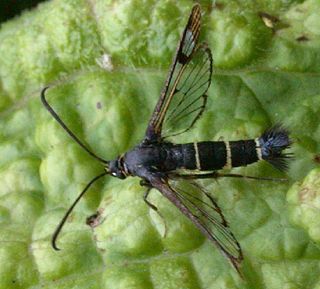
The Sesiidae or clearwing moths are a diurnal moth family in the order Lepidoptera known for their Batesian mimicry in both appearance and behaviour of various Hymenoptera.
Sir George Francis Hampson, 10th Baronet was an English entomologist.

The Pyralinae are the typical subfamily of snout moths and occur essentially worldwide, in some cases aided by involuntary introduction by humans. They are rather rare in the Americas however, and their diversity in the Australian region is also limited. Altogether, this subfamily includes about 900 described species, but new ones continue to be discovered. Like many of their relatives in the superfamily Pyraloidea, the caterpillar larvae of many Pyralinae – and in some cases even the adults – have evolved the ability to use unusual foods for nutrition; a few of these can become harmful to humans as pests of stored goods.

Cisthene is a genus of lichen moths in the family Erebidae. The genus was erected by Francis Walker in 1854.

Eucereon is a genus of tiger moths in the family Erebidae. The genus was erected by Jacob Hübner in 1819.

The genus Crambus includes around 155 species of moths in the family Crambidae, distributed globally. The adult stages are called crambid snout moths, while the larvae of Crambus and the related genus Herpetogramma are the sod webworms, which can damage grasses.
Lobobasis is a monotypic moth genus in the family Erebidae. Its single species, Lobobasis niveimaculata, is found from the Indian state of Sikkim, Bhutan and Sundaland to Queensland, the Solomon Islands and New Guinea. The habitat consists of lower montane forests, upper montane forests and various types of lowland forests. Both the genus and species were first described by George Hampson in 1896.

Lophocampa is a genus of moths in the family Erebidae. The genus was erected by Thaddeus William Harris in 1841. It contains around 75 species.
Paracles is a genus of moths in the subfamily Arctiinae. The genus was described by Francis Walker in 1855. The species range from Panama to Patagonia, with quite a few in the southern temperate region of South America.

Pseudosphex is a genus of tiger moths in the family Erebidae. The genus was erected by Jacob Hübner in 1818. These moths are mimics of a variety of Hymenoptera. The prefix pseudo means "false", and Sphex is a genus of wasps.

Saurita is a genus of moths in the subfamily Arctiinae. The genus was erected by Gottlieb August Wilhelm Herrich-Schäffer in 1855.

Culladia is a grass moth genus of subfamily Crambinae, tribe Crambini. Some authors have assigned the synonymous taxon Nirmaladia to the snout moth family (Pyralidae), where all grass moths were once also included, but this seems to be in error.

Eristena is a genus of moths of the family Crambidae, found in southern and eastern Asia.

Palpita is a genus of moths of the family Crambidae. Members of the moth genus Stemorrhages may be very similar in appearance.

Paracymoriza is a genus of moths of the family Crambidae.

Piletocera is a genus of moths of the family Crambidae. The genus was first described by Julius Lederer in 1863.

Scirpophaga is a genus of moths of the family Crambidae described by Georg Friedrich Treitschke in 1832. Asian species include significant rice stemborer pests.
Asplenia melanodonta is the only species in the monotypic moth genus Asplenia of the family Noctuidae. The species is found in Africa. Both the genus and the species were first described by George Hampson, the genus in 1916 and the species in 1896.

Phycita is a genus of small moths belonging to the snout moth family (Pyralidae). They are the type genus of their tribe Phycitini and of the huge snout moth subfamily Phycitinae.

Metarbela is a genus of moths in the family Cossidae described by William Jacob Holland in 1893.















